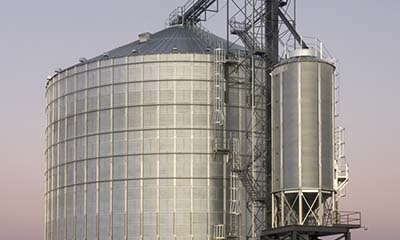February 24, 2016

With many bins still full, the National Corn Growers Association reminds farmers of the importance of proper grain bin safety procedures during Grain Bin Safety Week, which runs Feb. 21-27.
The National Corn Growers Association offers a video highlighting safety procedures. To view the video, click here. A free DVD of the video, available while supplies last, can be requested by sending an email with your name and mailing address to [email protected]. The video was co-produced with the National Grain and Feed Foundation, the research and education arm of the National Grain and Feed Association.

Remember to follow proper procedures when removing grain from a bin. (Photo: Zoonar RF/Thinkstock)
First released in 2011, the video illustrates the threat bin entrapment can pose. Shot on location in several states, it provides a wide range of information, from prevention tips and background data on grain bin accidents. The project also involved interviews with professionals in the fields of grain bin safety research and rescue.
Grain Bin Safety Week also brings attention to the life-saving extraction methods and procedures to help improve responder and victim safety when farmers and other workers become entrapped or engulfed in grain bins.
The only way to safely remove someone trapped in a grain bin is to remove the grain around the person’s body using a grain rescue tube. Unfortunately, many fire departments and other first responders lack the grain rescue tube and training to perform a successful grain bin rescue.
Nationwide is collaborating with industry leaders and agricultural professionals on its third annual Nominate Your Fire Department Contest, which runs through May 31. It awards grain rescue tubes and hands-on training to help first responders save lives, thanks to the support of KC Supply Co., the National Education Center for Agricultural Safety and our other partners.
Practice grain bin safety
Due in part to increases of on-farm storage and large-capacity bins, grain bin accidents are likely to increase if farmers and commercial grain handlers chose to ignore the hazards and safe-work practices and procedures. The inside of a grain bin is not the place for taking short cuts.
Grain bin safety starts with maintaining grain quality in storage. With proper aeration and cooling of stored grain, farmers and commercial grain handlers can help prevent the formation of clumps, crusts or grain bridges that can interfere with grain flow and lead to dangerous grain bin entry.
More often, grain bin accidents occur when untrained or inexperienced workers or family members enter a grain bin without following proper grain bin entry procedures, such as wearing a safety harness secured to a life line.
Like quicksand, flowing grain can pull a 165-pound man down to waist level in seconds and bury him in less than a minute. Once grain gets above the knees, the amount of friction and pressure exerted on a person’s body makes escape without assistance nearly impossible.
Grain bin hazards aren’t limited to entrapment or engulfment. Other, equally-hazardous situations include toxic atmospheres, augers and Power Take-Offs (PTOs), bin collapses, fires and explosions, electrical components and even ladders. Identifying and understanding grain bin hazards is vital to keeping you and others safe.
Related information: Grain bin engulfment prevention from the National Grain and Feed Association
Source: National Corn Growers Association, Nationwide
You May Also Like




